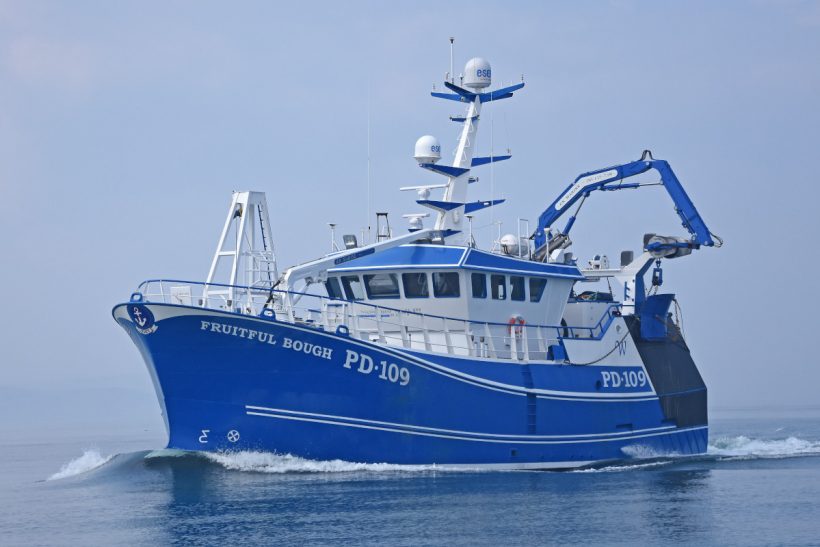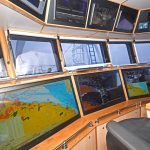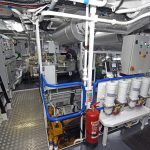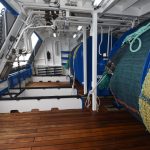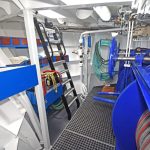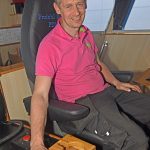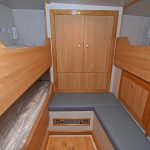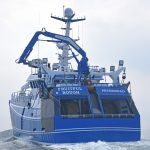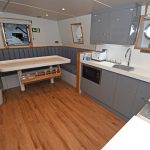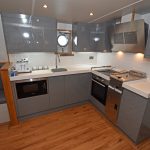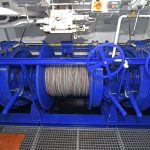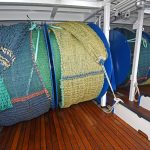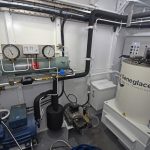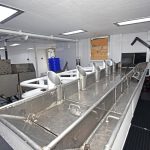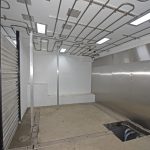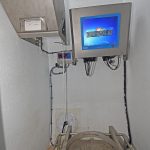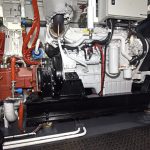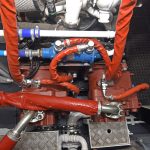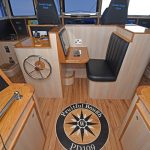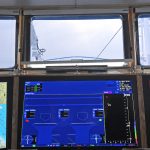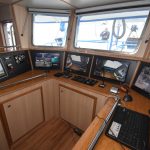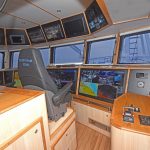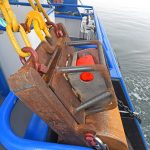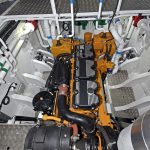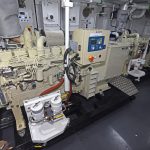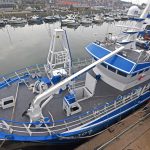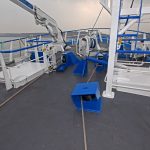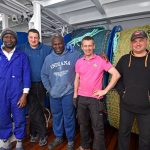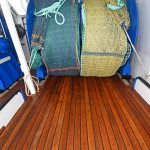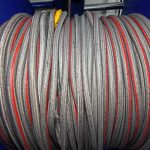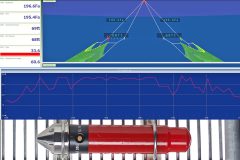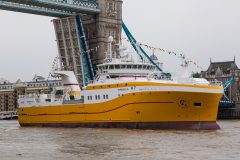Peterhead skipper Robert West takes delivery of new design of 22.3m twin-rig trawler from Parkol Marine Engineering
The newest addition to the Peterhead fleet, Fruitful Bough, arrived in its home port for the first time last week, following an 180-mile delivery trip from Whitby, when skipper Robert West and crew immediately took onboard boxes and stores, before running off to the North Sea prawn grounds, reports David Linkie
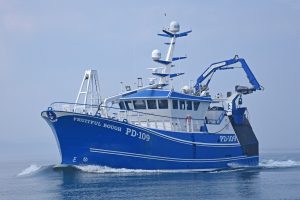
The 22.3m LOA Fruitful Bough is the first of a new design of twin-rig trawler.
Fruitful Bough sailed on its maiden trip less than one year after skipper Robert West signed the new-build contract with Parkol Marine Engineering at the 2018 Aberdeen Expo. By being completed ahead of schedule, Fruitful Bough is expected to have got a couple of landings in before the official naming ceremony at Peterhead next month.
Of round bilge hull form, the fully shelterdecked Fruitful Bough was built for skipper Robert West and partners (Fruitful Bough Fishing Company) to replace a 19.9m vessel of the same name, built by Macduff Shipyards in 2004.
Shortly before the new Fruitful Bough was launched at Whitby last month, its predecessor was renamed Jenny Amber PD 223, after Robert West’s eldest daughter. A further name change took place last week when the Caterpillar 3412-engined trawler became Gracious PD 103, after being bought by Peterhead skipper David West.
Insured by Sunderland Marine and working through Denholm Fishselling Ltd, Fruitful Bough is expected to follow the well-established pattern of fishing six- to seven-day trips before landing into Peterhead, with prawns being the main focus throughout the year. Robert West will share wheelhouse duties with relief skipper Alistair Reid.
A number of local Peterhead and Fraserburgh companies, including Blue Anchor Fire and Safety, Caley Fisheries, Faithlie Trawl, Jackson Trawls, Premier Refrigeration, RD Buchan & Sons, Scanmar UK and Woodsons, supplied equipment and fishing gear to Fruitful Bough.
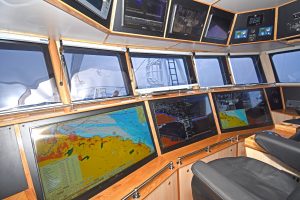
Display configuration on three 49in screens in the main wheelhouse console is controlled through Woodsons’ new 4K Multiview system.
While returning to Whitby on a tranquil morning, after completing fishing trials off Hartlepool, skipper Robert West said: “I’m absolutely delighted with the level of build quality and finish on Fruitful Bough. A lot of people and companies have contributed to the end result, so sincere thanks to everyone for ensuring that Fruitful Bough has been completed ahead of the date promised when the order was placed.
“The Parkol team deserve particular credit for ensuring a very smooth build programme, during which they were extremely amenable to suggestions.
“Fishing trials went without a hitch, and provided a brief snapshot of Fruitful Bough’s potential, in terms of towing capabilities, fuel economy and quiet running. Doubtless considerably more challenging conditions are just around the corner, but I’m confident that Fruitful Bough will meet these head-on and prove to be a strong asset in years to come.”
Built to a new round bilge hull design, plans for which were drawn up by Ian Paton of SC McAllister & Co Ltd, Fruitful Bough has main dimensions of LOA 22.3m, registered length 21.12m, beam 7.5m, moulded depth 4.14m, draft 5m and GT 215t.
Particular consideration was given to the bow and underwater stern sections, from the differing perspectives of combining maximum deck space forward, load carrying and vessel trim throughout a trip, with propulsion efficiency and seakeeping qualities. The result is a full bulbous bow and fine waterline entry, above which there is a considerably concave raked stem and strongly flared bow section, to ensure that the vessel’s beam of 7.5m is carried well forward, while the aft lines sweep up to the transom.
Forward, the flared bow shell plating blends stylishly into the traditional tumblehome shelter sides at the sweeping sheerline rail. The bold sheerline is a key visual signature mark of Fruitful Bough. Running from the traditional main deck rail position aft, and dipping amidships to rise steeply to above the shelter at the bow, this resembles the wave crest/trough/crest profile of a boat at speed.
When the hull design was finalised, Deri Jones Associates generated the cutting information, which was then transferred to Holland for cutting and forming of the double curvature shell plating, for subsequent delivery by road to Whitby.
General arrangement
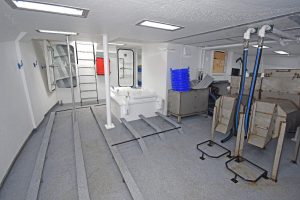
General views of the quarter…
Fruitful Bough features a generally conventional layout for this type of vessel.
Below the main deck, the hull is divided into forepeak, fishroom, engineroom and accommodation cabin. The latter is neatly arranged to give a single-berth skipper’s cabin to starboard, forward of seven bunks arranged on either side of the central compartment housing the Wills Ridley steering gear.
Under the full-length shelterdeck, a wide passageway, positioned along the port side of the hull, connects the forward catch-handling area to the quarter. Individual heated oilskin storage lockers are arranged against the side of the hull amidships in this area, together with bench seating, WC and hand-washing facilities. As well as leading to the deck house and engineroom, the passageway also provides walk-in access to a general storage compartment located in the forward port corner of the casing.
An additional bulkhead is fitted on the main deck forward, to create a large dedicated winch room. A walk-in compartment housing the fishroom refrigeration machinery, together with a 2.5t Geneglace flake ice machine and a Nilfisk pressure washer, is situated aft of the winch room and inboard of the square reception hopper.
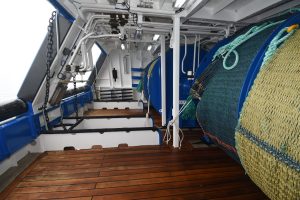
… and the fully-lined catch-handling deck amidships.
The catch-handling area is kept free of excess water from the fish washers by two deck sumps, drained by electrically driven Azcue pumps. The deck in this area received specialist treatment from BPB Services of Fraserburgh, being coated with Degafloor hardwearing non-slip resins. Having been impressed by the qualities of similar deck coatings on the previous Fruitful Bough, skipper Robert West had no hesitation in again opting for four-coat Degafloor resin compounds, in which quartz aggregate stays suspended at the top surface of the coating to give high adhesion properties.
Arranged along the full starboard half of the deck house, the immaculately finished combined galley/messdeck is equipped with the usual range of modern electrical appliances.
Separate washing and tumble-drying facilities are housed in the central passageway opposite the shower/toilet room.
All internal accommodation areas on Fruitful Bough are finished to an extremely high standard, using a combination of solid timber and colour-co-ordinated modern materials to give an attractive and homely look.
Twin-rig trawling arrangements
The load-sensing hydraulic system and full package of deck machinery installed on Fruitful Bough were custom-designed, manufactured and commissioned by EK Marine of Killybegs.
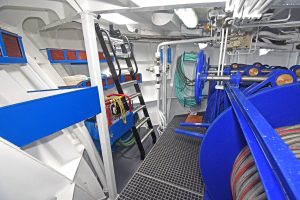
The three-drum trawl winch, supplied by EK Marine of Killybegs, is housed in a dedicated compartment forward.
Twin-rig trawling duties are carried out by a large three-drum trawl winch positioned forward on the main deck in the separate winch room, in which racks on the forward section provide additional storage options. Rated 33t core pull, the heavy-duty winch is fitted with two-speed drive motors for faster hauling and shooting of the wires. The winch barrels are spooled with 300 fathoms of 22mm-diameter covered Dyneema warp, supplied by Jackson Trawls of Peterhead.
Led up from the drums at nearly 35° to hooded rollers, the outer warps run across the top of the shelterdeck to a second set of sheaves, positioned near the sides of the shelterdeck midway along the wheelhouse, from where they are directed upwards towards hanging blocks mounted on the conventional trawl gantry.
The middle wire runs slightly to starboard under the wheelhouse floor, before leading upwards to run through a hanging block mounted on the underside of the trawl gantry, directly above a secure track for the safe storage of the middle roller.
The customary hardwearing UHMW-PE sheathing panels and strips are secured to outer hull areas in line with where the trawl doors and middle roller are worked, to minimise abrasion, wear and paint discolouration.
Two sets of 2 x 12t split net drums are arranged side by side on the hardwood-decked quarter, in line with the transom shooting and hauling hatches, the lower edges of which are fitted with large-diameter free-turning rollers. An interesting little feature on the transom rail is the presence of weld-profiled and painted numbers running from 1-20. Corresponding to feet, this arrangement provides a permanent tape measure that frequently comes in handy when the crew are working with chains.
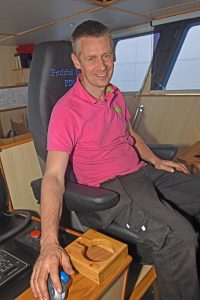
Skipper Robert West.
A 1.5t @ 7.8m kinked-boom crane, fitted with a Thistle 24in W-sheave powerblock, is centrally fitted atop the trawl gantry. Two general-purpose 3t Rotzler gear-handling winches are fitted on either side of the crane, to give further options when working twin-rig trawls and dealing with boulders and other fraps.
The codends are taken aboard forward on the starboard side by a 7.5t Gilson winch, mounted forward of a square-framed lifting gantry arranged over a hydraulically operated hatch and a large-capacity reception hopper.
All the necessary Fleming Fairleads hanging blocks and deck rollers were manufactured by F&R Belbin of Tynemouth.
After being released from the codend into the hopper, the catches are gravity-fed onto an elongated sorting table that extends aft.
Standing with their backs against the starboard side of the boat, the crew sort and gut the catch off the table. Selections are placed in elevated baskets, while prawn tails are directed into baskets on the deck via separate chutes.
Twin prawn/whitefish washers are positioned on the vessel’s centreline adjacent to the sorting area. A rectangular prawn dip tank is positioned on the vessel’s centreline, against the room housing the fishroom refrigeration machinery and ice machine.
Customary deck rails – between which baskets of prawns and fish are securely held before being passed down to the hold through the deck hatch, which is offset to port of the vessel’s centreline – extend the full length of the catch-handling deck. Spare baskets are securely stored against the foreside of the deck casing.
In order to ensure ease of cleaning and promote optimal levels of hygiene, the catch-handling area is fully lined and coated with several layers of GRP matting, to provide a durable waterproof finish on completely flush surfaces that, including flush lighting units, are easily cleaned down.
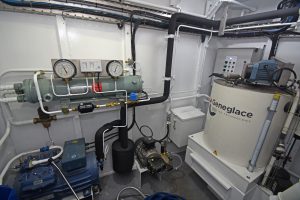
Fishroom refrigeration plant, and a 2.5t Geneglace ice machine, are housed in a walk-in room inboard of the catch reception hopper.
The deck racks are also coated with Degafloor resin to promote quicker cleaning time.
On being lowered down to the fishroom, catches are weighed and labelled using a set of electronic Marel weighing scales and a VCU catch management system, from which the data is transferred to the wheelhouse for subsequent reporting by the skipper using an e-catch logbook.
Capable of holding 450 stacker boxes in four tiers aft of the hatch, the fishroom has a working capacity of approximately 800 boxes. Five hundred boxes are usually taken onboard at the start of a trip. Up to 5t of flake ice can be stored in a full-height locker on the starboard side, directly under the 2.5t Geneglace unit housed in a dedicated compartment on the main deck.
In order to ensure that catches are landed in optimum condition, Premier Refrigeration Ltd of Fraserburgh fitted chilling to both the forward and aft bulkheads, as well as the deck head.
The copper chilling pipes fitted to the vertical bulkheads are protected by stainless steel sheeting. Stainless steel 22mm-diameter piping is mounted on the deckhead.
Automatically controlled from the wheelhouse and set to the required temperature by a digital thermostat, the cooling plant comprises a Bock compressor, an Azcue water pump driven by a three-phase electric motor, and a Blitzer seawater condenser.
The bilges under the fishroom floor are served by an automatic pump.
Catches are discharged from the fishroom using an EK Marine 1t x 8m straight-boom crane fitted with a 1t landing winch.
Engineroom
Fruitful Bough is powered by an electronically controlled Caterpillar C18 ACERT main engine, supplied by Finning UK Ltd.
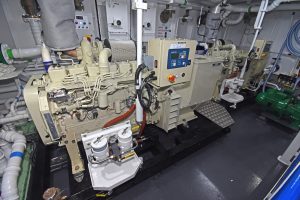
Two Cummins 6B auxiliary engines run 100ekW generators.
Developing 447kW @ 1,850rpm, and solely dedicated to propulsion duties, the main engine drives a 2,400mm-diameter four-bladed fixed-pitch Teignbridge propeller turning in a modern high-thrust, low-drag nozzle, fabricated by the boatyard, through a Masson Marine MMW 6000 gearbox of 9.916:1 reduction.
Engine and fishing trials demonstrated encouraging results with the stern gear, which was machined by Premier Engineering of Scarborough and is fitted with Lip Seals, delivering a very smooth and quiet performance in all operating modes, and strong towing performance.
The centreline combination, together with a single rudder, gave Fruitful Bough an average speed of 10 knots on sea trials.
A Cummins QSL9 auxiliary engine (212kW @ 1,800rpm), mounted on the port tank top, powers the deck machinery hydraulics through a JBJ clutched splitter box driving two Kawasaki load-sensing 115kW pumps.
An electrically driven 30kW power pack is used to drive a load-sensing hydraulic towing pump, as well as provide back-up hydraulic power. This arrangement also enables the deck machinery to be operated in harbour, when the crew are either mending or taking on gear while routine maintenance work is carried out on the main engine.

An electrically driven 30kW power pack is used to drive a load-sensing hydraulic towing pump, as well as provide back-up hydraulic power.
Installation of the vessel’s hydraulic system was completed in-house by Parkol Marine Engineering, with CuNiFe (copper/nickel/iron alloy) being used throughout.
A hydraulically powered Kort bow thruster of 90kW is fitted to give maximum vessel manoeuvrability in restricted areas.
Electrical supplies on Fruitful Bough are provided by two Cummins 6B auxiliary engines of 80kW @ 1,500rpm, running 100kVA Newage Stamford 415/3/50 generators.
Cooling for all four engines and the hydraulic system is provided through NRF box coolers arranged across the forward end of the engineroom. Stainless steel piping is used extensively throughout the engineroom.
One Vikron 80-amp charger is fitted to charge the three sets of batteries in the engineroom. A similar Vikron charger is situated in the wheelhouse to serve the lighting batteries, in addition to a 50-amp GNDSS charger.
Pearson Electrical of Hull was subcontracted by Parkol Marine Engineering to undertake the electrical installation work on Fruitful Bough alongside the boatyard’s own electricians.
A combination of 2 x 5,300-litre and 2 x 3,350-litre wing tanks in the engineroom allow 18,700 litres of fuel to be carried. A forepeak tank holds 17,600 litres of freshwater.
Twin-rig prawn trawls
The twin-rig prawn trawls that Fruitful Bough is now using were made in Peterhead by Caley Nets, and by Faithlie Trawl at Fraserburgh.

Trawl lead and hatch arrangements atop the shelterdeck.
Willie Hepburn and the Faithlie Trawl team made 160ft letterbox-style low-flyer nets, rigged on 6in and 8in discs. Standing less than 3ft high, this bespoke design of net, which is now widely used by prawn skippers at Fraserburgh and further afield, was developed specifically to minimise unwanted by-catches of whitefish. Given that these nets are usually fished in some 75 fathoms of water on the main North Sea prawn grounds, and therefore target less than 0.5% of the water column, this highlights the extent to which Scottish fishermen and net-makers continue to lead from the front in Europe with regard to innovative ideas to address landing obligation requirements.
Peter Noble and the Caley Nets team supplied a set of similar-sized prawn scraper trawls, again rigged on 6in and 8in discs.
Skipper Robert West is using the fairly standard arrangement of 50 fathoms of 34mm-diameter four-strand combination warp and 10 fathoms of 20mm-diameter wire rubber legs (made by Jackson Trawls), to connect the twin-rig gear to a 1,000kg middle roller, made by R&D Buchan & Sons of Peterhead, and a set of Thyborøn Type 11 66in/600kg trawl doors.
Jackson Trawls of Peterhead supplied the 22mm-diameter covered Dyneema warp, of which 3 x 100-fathom lengths are spooled on each barrel of the trawl winch.
The lazy pennants and associated trawl chandlery also came from Jacksons.
Woodsons 4K Multiview first for Fruitful Bough
Fruitful Bough is the first new build of its class to be fitted with Woodsons’ new 4K Multiview control system.
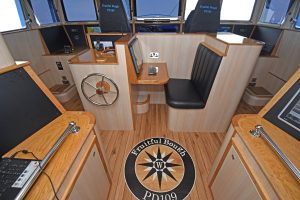
A customised compass rose is incorporated into the wheelhouse floor, between the trawl console and the central desk area.
Similar in principle to the operational systems that have become standard on pelagic vessels in the past 18 months, the 4K Multiview enables skipper Robert West to select his preferred viewing arrangements, either by using his iPad presets recalling predetermined fishing, steaming and in port screen layouts, or manually via the integrated control software.
Control of all equipment interfaced on the system is via a single trackball mounted in the central console which seamlessly moves the cursor from display to display until entering into and taking control of whichever equipment Robert requires at that time.
The 4K Multiview control system is integrated to the three 49in 4K screen displays incorporated in the main forward wheelhouse console as well as a further eight AG Neovo 24in glass-fronted wide-screen monitors which are arranged in either the overhead console forward or aft at the central trawl console.
The three big display screens accentuate the clean and streamlined appearance of Fruitful Bough’s wheelhouse, which skipper Robert West described as being ‘superb, and finished to exceptionally high levels of craftsmanship and quality’.
Two NorSap skipper’s seats, with the vessel’s name embroidered on the headrest covers, are positioned either side of a central island console. This arrangement is backed by a desk area, and ensures easy access throughout the wheelhouse, in which the trap leading to the main deck is positioned in the aft-port corner.
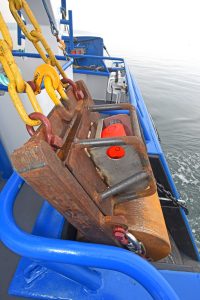
Fruitful Bough’s Scanmate 4 double-distance twin-rig net-monitoring system is served by three Scanmar SS4 sensors fitted in secure pockets on the Thyborøn Type 11 trawl doors, and the middle roller clump, manufactured by R&D Buchan & Sons of Peterhead.
The main forward console is returned along the sides of the wheelhouse to form steering consoles forward of raised standing platforms. These provide optimum forward vision when Fruitful Bough is being manoeuvred in confined areas.
Bottom-sounding and fish detection duties onboard Fruitful Bough are handled by a Simrad ES80 split-beam dual-frequency 38kHz/200kHz echosounder.
Skipper Robert West chose a Scanmate 4 twin-rig double-distance monitoring system, supplied and installed by Scanmar UK of Peterhead, to provide continual numerical and graphical updates of the middle clump’s position in relation to the trawl doors, to ensure optimum levels of fishing efficiency, in terms of both gear spread and fuel economy.
In a fishery where maximising gear spread and symmetrical net geometry are of paramount importance, the information provided enables the position of the middle clump to be adjusted whenever the need arises, by eliminating any doubt from the mind of a skipper as to whether the clump is in line with, in front of, or behind the trawl doors.
Details of Fruitful Bough’s position are processed by two Furuno GP39 GPS receivers, and heading is provided by a Hemisphere V102 GPS gyrocompass. Positioning data received is interfaced to Olex 3D seabed mapping and Sodena EasyWin plotting systems, which support tidal data, AIS and ARPA tracking.
The Koden MDC-7012S main radar is backed up by a Koden MDC-5004T unit. Both radars are interfaced to a Jotron TR-8000 Class A AIS transceiver and, with ARPA, provide tracking through the Olex and Sodena EasyWin plotters.
Steering and navigation are taken care of by a Navitron NT921 MKII digital autopilot, with duplicate levers at the forward wing consoles and aft at the trawling station. A jog lever unit is also located at the transom rail.
Communications and safety equipment includes a Sailor 6310 150W GMDSS SSB radio telephone, Sailor and Icom DSC VHFs, Entel HT649 GMDSS handheld VHF, and Easy Navtex receiver.
Woodsons also installed comprehensive CCTV coverage, served by 2 x 8-camera systems. Two additional dedicated cameras are focused on the aft quarter.
Fruitful Bough’s CCTV system includes an underwater hull camera focused on the propeller, nozzle and rudder. Images from this, or any of the other cameras, look particularly impressive when displayed on the large screens.
Vivier-crabber in early stages of construction
A 19m vivier-crabber for Holborn Fishing Company Ltd, Caithness, is now in the early stages of fabrication at Whitby, where the vessel will be built in the same position that Fruitful Bough was lifted into the river Esk from last month.
Featuring a 32t vivier hold and two freezer bait stores, the crabber, which will have a registered length of 16.45m and a beam of 7m, will replace the owners’ present boat Sparkling Line WK 4.
A Mitsubishi S6A3 MPTAW 360kW main engine will drive a 1,900mm-diameter propeller through a Reintjes WAF274K gearbox of 7:1 reduction.
Construction of a totally new design of aft-bagging twin-rig trawler for Fraserburgh owners is also progressing well at Whitby, with engineroom and deck machinery, including 3 x 15t split trawl winches, now in situ, as internal fit-out of the accommodation areas continues.
Designed by SC McAllister & Co Ltd, in close liaison with Fraserburgh father and son skippers Sandy and Alexander West, Westward, and Virtuous LLP, the round bilge hull, which incorporates a new design of high-profile bulbous bow, has main dimensions of LOA 24m, registered length 23.1m, beam 7.8m and depth moulded 4.3m.
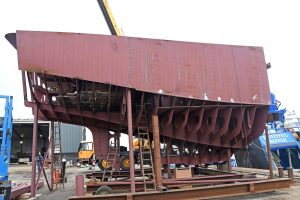
Fabricating the stern section of a 19m vivier-crabber for Scrabster owners, at the same time as Fruitful Bough prepares to leave the boatyard for Peterhead.
The codends will be hauled up a quadrant ramp centrally positioned at the transom, before catches are released through a bag hatch in the shelterdeck to a large reception hopper positioned to port of the vessel’s centreline. Catches will be worked along the port side of the main deck amidships, before being transferred to the fishroom, which will have a working capacity of some 900 boxes.
Incorporating the galley and messdeck, the main deck house will be arranged along the starboard side of the main deck amidships.
The vessel’s centreline machinery will include a Mitsubishi S6R2 T2-MPTK-3 main engine (555kW @ 1,350rpm), a Reintjes WAF 474 gearbox with a reduction ratio of 7.476:1, and a 2,500mm-diameter propeller and high-efficiency fixed nozzle.
The load-sensing hydraulic system will be driven by a Mitsubishi S6B3 variable-speed auxiliary engine (358kW). Electrical power will come from two Mitsubishi 6D24-T auxiliary engines driving 100ekW 125kVA Stamford generators.
Two contrasting types of bigger vessel are also being built in Parkol’s fabrication hall on Teesside.
One of these new builds is a 29.95m registered length versatile beam scalloper of 8.9m beam, being built to Class for West Coast Sea Products.
The vessel’s outer hull tipping doors and catch conveyors are being manufactured by EK Marine Ltd of Killybegs, together with pulling-down/ancillary winches and a general-purpose landing crane that will cover the beamer’s traditional open working deck amidships.
The Dutch company Padmos will supply the scalloper’s main electric-drive deck machinery, including two 26t split trawl winches and two derrick winches.
The beam scalloper will be powered by a Mitsubishi S12R MPTAW main engine of 749kW @ 1,500rpm, driving a 2,750mm-diameter fixed-pitch propeller through a Reintjes WGF773 gearbox of 12:1 reduction.
Main electric power will be delivered by a Mitsubishi S6A3-based 540kVA Stamford generator. Caterpillar C4 190kVA and Mitsubishi S4K 70kVA gensets will also be fitted.
The second new build, a 27m salmon farm fish feed carrier for Shetland owners LCL Shipping, which took delivery of a similar vessel, Havilah, from Parkol in 2015, is in the initial stages of construction at Middlesbrough.
Of 23.95m registered length, 9.70m beam and 4.80m amidships depth moulded, LCL Shipping’s new vessel will be powered by twin Cummins KTA19-M3 engines of 447kW @ 1,800rpm. Three Cummins auxiliary engines will also be installed.
FRUITFUL BOUGH PD 109
DETAILS
Owners: Fruitful Bough Fishing Company, Peterhead
Designer: SC McAllister & Co Ltd
Boatyard: Parkol Marine Engineering, Whitby
Agent: Denholm Fishselling Ltd
DIMENSIONS and CAPACITIES
Length overall: 22.30m;
Length reg: 21.12m;
Beam: 7.5m;
Depth moulded: 4.14m;
Draft: 5m; Tonnage: 215t gross; Fuel: 18,700 litres;
Freshwater: 17,600 litres;
Lube oil: 450 litres;
Hydraulic oil: 1,650 litres; Fishroom: 800 boxes; 5t ice
ENGINEROOM
Main engine: Caterpillar C18 of 447kW @ 1,850rpm driving through a Masson Marine MMW 6000 9.916:1 reduction gearbox to a Teignbridge 2,400mm-diameter four-bladed propeller; Speed: 10 knots
Auxiliary engines: Cummins QSL9 rated 212kW @ 1,800rpm driving deck machinery hydraulics through two Kawasaki load-sensing pumps and 2 x Cummins 6Bs rated 80kW @ 1,500rpm driving 100ekW generators
Bow thruster: Kort KT-120 hydraulically driven 90kW
Fuel and oil filters: CC Jensen
Bilge and deck pumps: 3 x Azcue electrically driven and 2 x Azcue deck suction pumps
DECK MACHINERY
Supplier: EK Marine Ltd, Killybegs
1 x three-drum two-speed trawl winch 33t; 2 x split net drums 2 x 12t; Gilson winch 7.5t; 2 x auxiliary gear-handling winches 3t; EKM powerblock crane (1.5t @ 7.8m) and Thistle 24in ribbed-head powerblock; EKM stiff-boom landing crane and winch (1t @ 8m)
FISH HANDLING/FISHROOM
Fish handling system: Parkol Marine Engineering;
Fishroom chilling: Premier Refrigeration Ltd, Fraserburgh; Ice machine: Geneglace 2.5t/day, Premier Refrigeration Ltd
ELECTRONICS
Suppliers: Woodsons of Aberdeen and Scanmar UK, Peterhead
Fish detection
Simrad ES80 split-beam dual-frequency 38kHz/200kHz echosounder; Scanmar Scanmate 4 twin-rig double-distance net-monitoring system
Navigation
Koden MDC-7012S and Koden MDC-5004T radars; 2 x Furuno GPS receivers; Olex 3D seabed plotting system c/w AIS, ARPA and HT module for hard and soft ground mapping; Sodena EasyWin plotter c/w AIS and ARPA modules; Navitron NT921 MKII autopilot c/w rudder feedback, watch alarm and Kobelt jog lever; Hemisphere V102 GPS gyrocompass; Windsonic ultrasonic wind speed and direction sensor
Communications
Sailor 6310 150W GMDSS MF/HF radio telephone; Sailor 6210 VHF; Icom M330 DSC VHF; Entel HT649 GMDSS hand-held VHF; Phontech 3100 five-way intercom system; Easy Navtex receiver; Jotron TR-8000 Class A AIS; Jotron TRON 60 GPS EPIRB; VCU catch management system c/w Marel scales; e-SEA 60Ka satellite internet system with wifi access in wheelhouse, messdeck and cabins; e-SEA 60 satellite TV system; CCTV system c/w 18 HD cameras and propeller camera system
FISHING GEAR
Warp supplier: Jackson Trawls, Peterhead – 3 x 300 fathoms of 22mm covered Dyneema warp; Net suppliers: Faithlie Trawl, Fraserburgh – 2 x 160ft twin-rig letterbox prawn trawls rigged on 6in and 8in discs; Caley Nets, Peterhead – 2 x 160ft twin-rig prawn scraper trawls rigged on 6in and 8in discs; Doors: Thyborøn Type 11 66in/600kg; Clump: RD Buchan & Sons, Peterhead – 1t roller
ACCOMMODATION
1 x single-berth and 1 x seven-berth cabins
GENERAL
Engine controls: Kobelt electronic three-station; Insurance: Sunderland Marine; Lifesaving appliances: Blue Anchor Fire and Safety Ltd, Fraserburgh; Paint: International; Steering: Wills Ridley; Wheelhouse seats: 2 x NorSap



